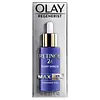What's inside
What's inside
 Key Ingredients
Key Ingredients

 Benefits
Benefits

 Concerns
Concerns

 Ingredients Side-by-side
Ingredients Side-by-side

Water
Skin ConditioningStearic Acid
CleansingParaffinum Liquidum
EmollientGlyceryl Stearate
EmollientCetearyl Alcohol
EmollientCeteareth-20
CleansingGlycerin
HumectantSodium Lactate
BufferingSodium Gluconate
Skin ConditioningRetinyl Acetate
Skin ConditioningPropylene Glycol
HumectantTriethanolamine
BufferingPanthenol
Skin ConditioningPhenoxyethanol
PreservativePentylene Glycol
Skin ConditioningMadecassoside
AntioxidantAcrylates/C10-30 Alkyl Acrylate Crosspolymer
Emulsion StabilisingAloe Barbadensis Leaf Extract
EmollientDisodium EDTA
Water, Stearic Acid, Paraffinum Liquidum, Glyceryl Stearate, Cetearyl Alcohol, Ceteareth-20, Glycerin, Sodium Lactate, Sodium Gluconate, Retinyl Acetate, Propylene Glycol, Triethanolamine, Panthenol, Phenoxyethanol, Pentylene Glycol, Madecassoside, Acrylates/C10-30 Alkyl Acrylate Crosspolymer, Aloe Barbadensis Leaf Extract, Disodium EDTA
Water
Skin ConditioningDimethicone
EmollientGlycerin
HumectantRetinol
Skin ConditioningRetinyl Propionate
Skin ConditioningNiacinamide
SmoothingTropaeolum Majus Flower/Leaf/Stem Extract
Skin ConditioningPalmitoyl Pentapeptide-4
Skin ConditioningDimethiconol
EmollientLaureth-4
EmulsifyingPolysorbate 20
EmulsifyingLaureth-7
EmulsifyingDisodium EDTA
Dimethicone Crosspolymer
Emulsion StabilisingPolyacrylamide
Titanium Dioxide
Cosmetic ColorantMica
Cosmetic ColorantC13-14 Isoparaffin
EmollientDMDM Hydantoin
PreservativeIodopropynyl Butylcarbamate
PreservativeWater, Dimethicone, Glycerin, Retinol, Retinyl Propionate, Niacinamide, Tropaeolum Majus Flower/Leaf/Stem Extract, Palmitoyl Pentapeptide-4, Dimethiconol, Laureth-4, Polysorbate 20, Laureth-7, Disodium EDTA, Dimethicone Crosspolymer, Polyacrylamide, Titanium Dioxide, Mica, C13-14 Isoparaffin, DMDM Hydantoin, Iodopropynyl Butylcarbamate
 Reviews
Reviews

Ingredients Explained
These ingredients are found in both products.
Ingredients higher up in an ingredient list are typically present in a larger amount.
Disodium EDTA plays a role in making products more stable by aiding other preservatives.
It is a chelating agent, meaning it neutralizes metal ions that may be found in a product.
Disodium EDTA is a salt of edetic acid and is found to be safe in cosmetic ingredients.
Learn more about Disodium EDTAGlycerin is already naturally found in your skin. It helps moisturize and protect your skin.
A study from 2016 found glycerin to be more effective as a humectant than AHAs and hyaluronic acid.
As a humectant, it helps the skin stay hydrated by pulling moisture to your skin. The low molecular weight of glycerin allows it to pull moisture into the deeper layers of your skin.
Hydrated skin improves your skin barrier; Your skin barrier helps protect against irritants and bacteria.
Glycerin has also been found to have antimicrobial and antiviral properties. Due to these properties, glycerin is often used in wound and burn treatments.
In cosmetics, glycerin is usually derived from plants such as soybean or palm. However, it can also be sourced from animals, such as tallow or animal fat.
This ingredient is organic, colorless, odorless, and non-toxic.
Glycerin is the name for this ingredient in American English. British English uses Glycerol/Glycerine.
Learn more about GlycerinWater. It's the most common cosmetic ingredient of all. You'll usually see it at the top of ingredient lists, meaning that it makes up the largest part of the product.
So why is it so popular? Water most often acts as a solvent - this means that it helps dissolve other ingredients into the formulation.
You'll also recognize water as that liquid we all need to stay alive. If you see this, drink a glass of water. Stay hydrated!
Learn more about Water